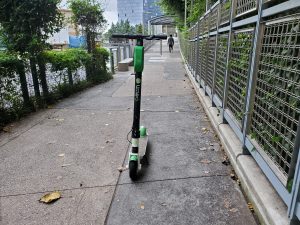Another One Bites The Dust?
 The recent news that one of the first entrants to to the Atlanta scooter market, Lime, is pulling out seemed to solidify the sense in many people’s minds that the era of scooters ubiquity – or perhaps even utility – is drawing to a close. Social media discussions of Lime’s departure are filled with comments from users happy to see them go, but the future of the “dockless sharable mobility devices” as the city chose to refer to them, is very much unclear. Will the remaining players be bolstered by the absence of competition or will Bird, Jump, and Wheels also retreat in time? Will the size of the remaining fleets rise to take up the slack, or is the current sparse allotment the new normal?
The recent news that one of the first entrants to to the Atlanta scooter market, Lime, is pulling out seemed to solidify the sense in many people’s minds that the era of scooters ubiquity – or perhaps even utility – is drawing to a close. Social media discussions of Lime’s departure are filled with comments from users happy to see them go, but the future of the “dockless sharable mobility devices” as the city chose to refer to them, is very much unclear. Will the remaining players be bolstered by the absence of competition or will Bird, Jump, and Wheels also retreat in time? Will the size of the remaining fleets rise to take up the slack, or is the current sparse allotment the new normal?
Since the announcement of the Mayor’s 9pm curfew, scooter availability has gone from ‘too-many-everywhere’ to ‘none-where-you-need-em’; and for many who ride them to MARTA stations after evening shifts, ‘verboten’ when they’re needed. Promised changes to infrastructure and regulation have been slow to arrive despite a purported timeline to enact scooter licensing reform and quick additions to tangible LIT (“Light Individual Transport” – a catchall phrase for scooters and bikes, etc.) infrastructure. There have been headwinds on the scooter business model worldwide (Lime pulled out of 12 markets around the globe, Atlanta among them) but we’ll probably never know if Lime’s operations in Atlanta could have been retained. We can only wait to see if the others follow them out the door.
In between the anti-scooter and pro-scooter camps, people in the transportation and transit advocacy sphere are nervous about the portents of Lime’s departure. While Uber and Lyft have been criticized for generating more traffic and vehicle miles than they reduced, their respective LIT incarnations have given rise to a transportation mode that truly addresses the infamous “Last Mile” problem of public transit: A way to get riders from bus stops and train stations to their final destinations quickly and efficiently. Industry watchers like myself are sad to see the easy access to scooters wane (they aren’t as effective a transportation solution if you have to go out of your way to pick one up) but acknowledge that scooters are a sidewalk tripping hazard and an additional impediment for wheelchair users on our already less-than-stellar sidewalk network.
So will we find the balance in this new environment? That depends on what measures the City and State take. The State Legislature may enact a more concrete definition for the scooters during this year’s session which runs from January to the end of March. Meanwhile, the City of Atlanta has yet to let the other shoe drop in their administration of the city’s scooter operator licensing and regulation scheme. Floating above all of this are the varying market conditions and international trade implications that affect the private transportation industry’s tactics – for instance, US Customs recently declared that eBikes can be considered motorcycles for import purposes, and therefore excluded from tariffs.
The future is, as ever, unclear; but love them or hate them, scooters and the rest of the “LIT” family of vehicles may among our best chances at reducing gridlock, reducing CO2 emissions, and restoring livability to cities.





